Shipping Containers with Electricity - A Modern Solution
NOVEMBER 3, 2021 BY

Electricity is an indispensable part of our lives. Whether it's our home, office, or store, we require electrical connections to run machinery and appliances, charge our gadgets, and make our environments more comfortable.
Modern shipping containers can accommodate electrical cables and outlets, fixtures, and accessories or even function as a battery or power source for supplying energy to electrical equipment in remote locations.
Shipping containers with electricity are a cutting-edge solution, especially when you need more than just storage. What makes shipping container conversion more interesting is that you can select a design where all the electric components remain concealed behind the container walls, giving you more freedom to modify your interiors.
The modular architecture of a container also allows you to install windows, shelving brackets, air conditioning units, plumbing, phone lines, and all kinds of shipping container accessories. That’s why modified shipping containers are an effective alternative to traditional buildings for creating functional spaces.
Let's take a closer look into how container electrification works, what components you can add, and how to install an electrical system in your container.
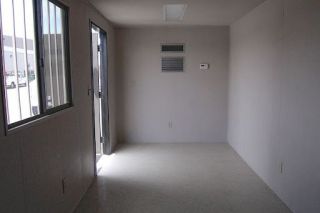
Electrical Installation Services
There are three ways you can opt for shipping container electricity installations: you can do it yourself, outsource the work to a container modification expert, or buy a container pre-installed with all the electrical utilities.
You can also choose to perform basic connections yourself and ask a shipping container conversion specialist to complete the more advanced connections such as air-conditioning, heaters, and broadband.
Each option has its pros and cons. For instance, if you DIY, it may be highly time-consuming. Lack of expertise can also lead to hazards.
However, you will have the freedom to choose the design. Outsourcing may be quicker but expensive. Lastly, buying a pre-built can be highly convenient, but you won't have much room to modify the existing design.
Let's look at the two most commonly selected options that remain a popular choice in building electrified container units:
- Standard packages and installations
- Do it yourself
Related: Learn how to keep your container safe with durable shipping container locks
Electrical Packages/Electrical Installations Offered in the Shipping Container Conversion
A standard electrical package for shipping containers may include strip lights, outlets, air conditioning, wiring, and phone/data lines.
Container manufacturers install lights and fixtures using the surface-mounted conduit wiring that lies behind the walls.
You can also customize your package and add exterior lighting, porch lights, wall or floor-mounted heaters, etc.
You can also discuss an appropriate configuration with your container supplier or ask for higher-rated switches and appliances as per your needs.
These are the electrical connections typically available in standard shipping container conversion packages:
GFCI Receptacles
Generally, shipping containers use a 110 V receptacle, similar to those used in traditional homes. You can choose a two or four outlet receptacle. In addition, you can have a flush-mounted receptacle or keep it exposed to the wall surface depending on the configuration of your container.
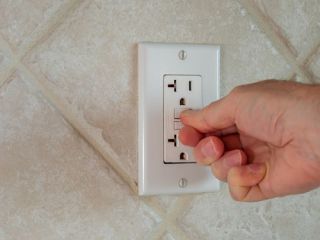
Overhead Lighting
Interior overhead lights help control the amount of brightness you need in your space according to your container's location.
Most manufacturers provide two lights for a 20-foot container or four lights for large 40-foot units.
However, you can discuss with your manufacturer and configure the number of lights to meet your specs.
You can also ask your manufacturer to install multiple switches to turn on/off the lights from anywhere inside the container.
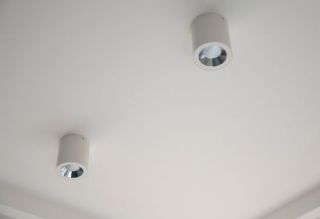
LED Lighting
Container providers offer LED lights as part of your package in remote locations with limited access to on-site power sources.
The most significant advantage of LED lights is that you can also hook them up to a small battery and illuminate your container in the absence of on-grid power.

Flood Lights
If you intend to keep the surrounding perimeter of your container well-illuminated, you can ask for exterior floodlights. Some suppliers also provide lights with motion sensors to save electricity costs.

Porch Lights
You can also choose a porch light as a part of your package for illuminating the immediate area near your container's door or window. These lights are incredibly functional and also add to the aesthetics of container homes.
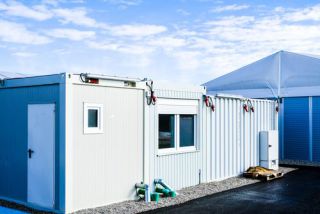
Phone and Data Cables
Most office activities require phones and the internet. Manufacturers use CAT5 lines for internal hard-wired telephones and terminate them to a nearby outlet. This allows you to run multiple data and phone connections per your needs.
Heaters and Air Conditioners
Conventionally, most container suppliers offer a 2 KW floor or surface-mounted convector heater or an air conditioner to help maintain the ideal temperature in your space.
How to DIY the Electric Installations in a Container?
If you choose to DIY the electric installations in a shipping container, follow these steps:
First, select an appropriate layout and design plan to determine the positions of the utilities in a container. You must ensure that all electrical connections in your project meet the National Electrical Standards (NEC in the U.S.) and local building codes.
A shipping container home or office being a metal box is subject to more stringent safety standards than traditional homes. For instance, you can use a non-metallic (NM-type) sheathed cable to install lights and outlet circuits.
However, using bare electrical wire in a container may expose the entire structure to high voltage and risk potential electrocution.
We recommend following the NEC for a safer design. If your container house or office has access to a grid, you must take the help of a certified electrician to install power meters and then start making connections.
We can divide the entire electrical installation process into these three areas:
Exterior Power Connections:
If your container structure lies close to a power grid, you can use an appropriate, rated aerial cable (which can provide the required current and function as a ground wire) to power the structure.
You must secure the aerial cable above the ground level using posts or tree trunks for safe operations.
Please note that if you're using an aerial cable and external sockets, you must ensure that the source socket has a GFCI (Ground Fault Circuit Interrupter)/ (RCD – Residual Current Device) protection.
Additionally, you must build an aerial connection with a single continuous cable from the source to your building.
Alternatively, you can conceal the primary wires in a trench using a plastic conduit (schedule 80 PVC).
The NEC specifies the minimum burial depth at 1.5 feet. It is also beneficial to increase the burial depth in cold zones to avoid freezing-related mechanical stress.
You can also bury the underground feeder (UF) cable without a conduit so long as you're using a trench of at least two feet deep. However, some places make it mandatory to use conduits where UF cables leave the ground and lie exposed.
Interior Wiring
Once you have obtained the power supply and determined the locations of the electrical fixtures, you can use conduits, raceways, or Romex cables to make the interior connections.
Conduits are safe and cost-effective for routing wires along the selected path in walls intended for spray-foam or blanket-type thermal insulation.
However, if you're using rigid block-foam insulation such as polystyrene, polyurethane, or phenolic foam, accommodating conduits can be tricky and lead to discontinuity in insulation.
Presently, block-foam panels such as InSoFast's CX 44 and UX panels function as efficient raceways. These raceway panels have a unique design with wire routings, especially for accommodating a container wall's corrugated pattern.
In low-voltage DC transmissions, you can use Romex cables to avoid overheating. You can address the internal heat problem by selecting the proper size of wires and diameter of conduit to reduce the heat to safe levels.
After connecting the wiring in your unit, you can create plug points and outlets for lighting and other appliances.
Grounding and Earthing System
Grounding and earthing systems protect your container from electroshocks and also ensure that the container's metal structure is at the 'zero reference potential' level.
They provide adequate voltage drop to pass off any excess supply so that the container's body stays neutral or reliably close to the earth's potential range.
Although grounding and earthing may seem the same, their implementation is entirely different.
In grounding, you must use a robust wire connected to the metal rod (stick, plate, etc.), insert it into the ground (earth), and connect the opposite end of the wire to the current-carrying part of the equipment.
This kind of connection helps set the potential of that point as zero, with reference to the earth's potential.
You must connect the opposite side of the wire to the metal parts or body of the equipment during earthing. The earthing wire stays separate from the current-carrying wire by an insulation barrier and protects us from shocks in case of electrical faults.
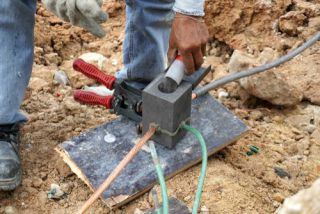
Once you have installed appropriate grounding systems, your container with electricity is ready for use.
Watch how a container specialist installed electrical connections on his own using raceways to turn his container into a fully functional space.
Legal Disclaimer:
The details provided above are purely for informational purposes. We strictly advise you to adhere to the NEC and building codes or take the help of a professional to avoid any hazards.
Common Uses of Electrics in a Shipping Container Structure
Listed below are some standard electrics in a shipping container structure and their common uses:
- Lights: Lighting connections help illuminate your storage, offices, and container buildings while also adding to their safety.
- HVAC: Heating, Ventilation, and Air-conditioning units maintain optimum temperature during the cold winter chills and scorching summer heat. These utilities are also crucial as they prevent moisture accumulation that may otherwise lead to corrosion or mold.
- Sockets: Power sockets are essential for running our gadgets, charging our phones' batteries, and operating all types of power tools and equipment.
- Food Preparation: Shipping container restaurants, cafes, and even homes need water heaters, extractor fans, ovens, grinders, and other appliances for making food and heating water.
- Internet: Electric connections are essentials for setting up broadband and data lines for seamless connectivity.
How Can MMPS Help?
Mobile Modular Portable storage is the leading supplier of high-quality shipping container storage, offices, and combo units. Our pre-built office and combo units come equipped with GFCI receptacles, lighting, HVAC and heat strips, and data access lines. With our own fleet of vehicles, we offer the fastest container delivery once you place your order.
Call us at 866-459-7600 or get in touch with our container specialists for suggestions on the most appropriate solution for your application and budget.
FAQs
How Do Shipping Containers Get Electricity?
Shipping containers can get electricity from the grid or source power from off-grid sources such as solar panels, wind, and diesel generators.
Are Shipping Containers Energy-Efficient?
Shipping containers being compact units may consume less energy depending upon your usage. You can also install LED lights, solar panels or modify the container's design to make it more energy-efficient.
Should a Shipping Container be Grounded?
Shipping container units have a metal body, making them susceptible to electric shocks in case of faults. That’s why you must ground them to avoid any hazards.
